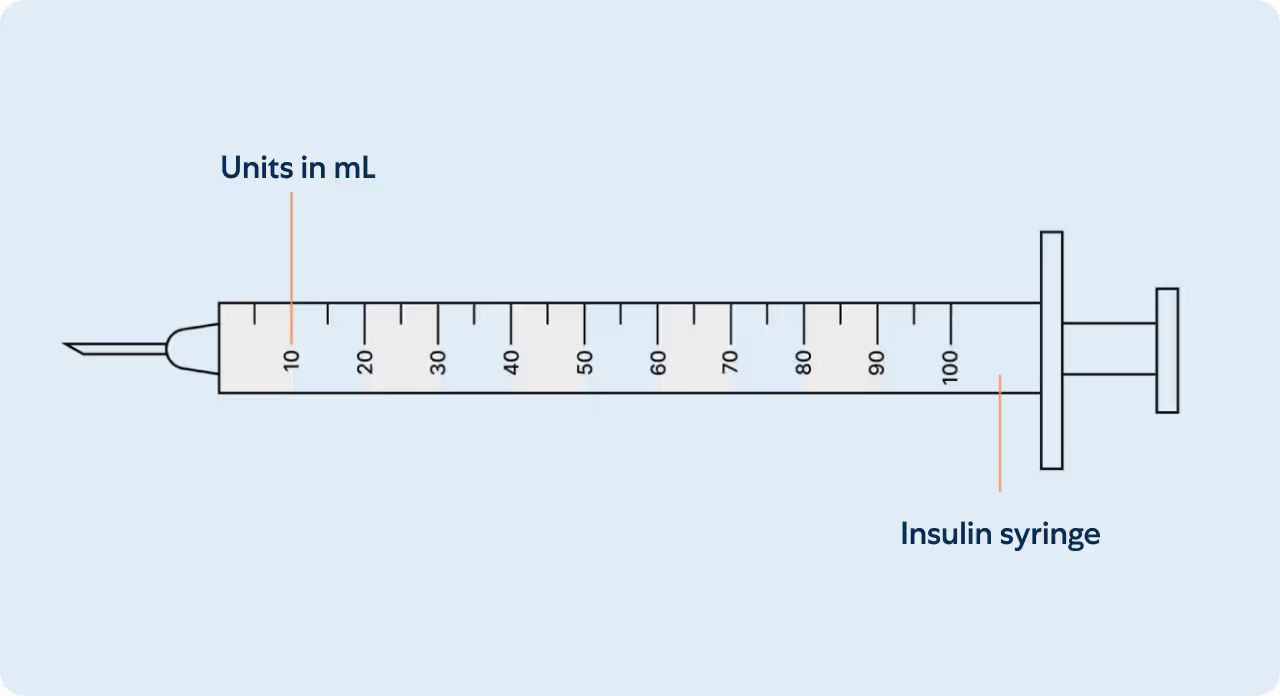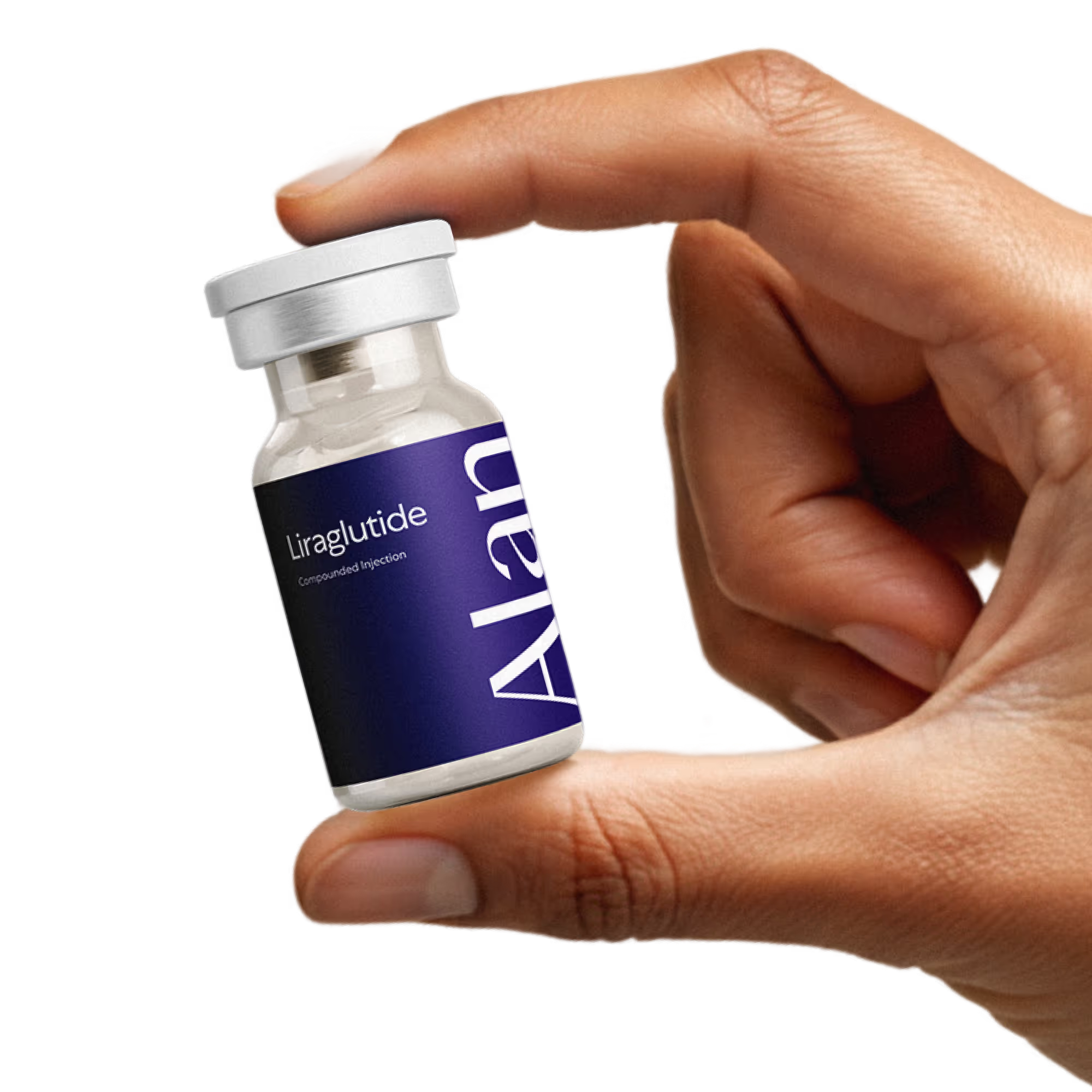Storage
Always refrigerate your vial at 36–46 °F (2–8 °C), never freeze it, and avoid storing it next to the cooling element. Protect your vials from direct sunlight and heat.
Instructions
This information is intended for individuals who have been prescribed Liraglutide by their Alan Health provider.
Inject once daily as directed by your healthcare provider using a vial and syringe.
{{injection-video}}
Clean the injection site, insert the needle at a 45–90-degree angle, and inject the medication slowly. Hold until fully administered. Rotate injection sites daily to avoid irritation.
- Prep Your Supplies: Wash hands and gather the liraglutide vial, insulin syringe, alcohol swabs, and a sharps container. Inspect the solution—it should be clear and free of particles.
- Draw the Dose: Clean the rubber top of the vial with an alcohol swab. Inject air into the vial equal to your prescribed dose, then draw up the exact amount. Remove any air bubbles by tapping the syringe and pushing gently on the plunger.
- Pick an Injection Site: Use the abdomen (at least 2 inches from the belly button), thigh, or upper arm. Clean the area with an alcohol swab and allow it to dry completely.
- Inject: Gently pinch the skin. Insert the needle at a 45–90° angle, depending on needle length and body type. Inject the medication slowly and steadily. Once done, remove the needle and apply gentle pressure with a clean swab. Dispose of the syringe safely in a sharps container.
Compounded Liraglutide is prescribed with a personalized, clinically-guided titration plan. Starting low and increasing gradually helps your body adapt to the medication—minimizing side effects while maximizing long-term benefits. Try to take your dose at the same time each day—staying consistent helps your treatment work at its best.
Your titration journey is guided by your Alan clinician and tailored to your health profile. Our standard titration schedule should be followed, unless your prescriber tells you differently:
{{titration-table-compounded-liraglutide}}
If your medication has a seal, watch this video to learn how to remove it.
To learn how to inject your medication subcutaneously, please watch this video.
Missed Dose? If you miss a dose, skip the missed dose and continue with your regular schedule. If you have any questions about your dosing schedule, contact your Alan Health provider.
Understanding your insulin syringe

Measuring your dose
Insulin syringes are used for subcutaneous injections. They are marked in Units on the insulin syringe barrel (see illustration). Insulin syringes facilitate the precise measurement of tiny amounts of liquids which are ideal for medications such as insulin that require small and accurate dosing. Unit marks are also expressed in mL’s and can be interchangeably referenced. A prescriber may write a prescription in Units or in mL’s.
Within the amount of liquid is the prescribed mg dosage of your medication (see mg chart). Milligrams (mg) is not an amount of liquid, but rather the amount of drug that is within. The conversion between units and milligrams varies depending on the concentration of the product being used.
What can I expect?
Safety information
The most common side effects of liraglutide include nausea, diarrhea, and vomiting.
Other common side effects may include injection site reactions, constipation, abdominal pain (including upper abdominal pain), increased lipase levels, headache, fever (pyrexia), fatigue, indigestion (dyspepsia), dizziness, low blood sugar, and gastroenteritis. If these symptoms persist or worsen, stop taking the medication and contact your healthcare provider.
A full list of side effects can be found here.
Indications
Liraglutide is a prescription GLP-1 receptor agonist indicated:
- As an adjunct to a reduced-calorie diet and increased physical activity for chronic weight management in adults.
BLACK BOX WARNING: Risk of Thyroid C-Cell Tumors
In animal studies, liraglutide caused thyroid C-cell tumors, including medullary thyroid carcinoma (MTC). It is not known if this risk applies to humans.
Do not use liraglutide if you:
- Have a personal or family history of MTC or Multiple Endocrine Neoplasia syndrome type 2 (MEN 2).
- Are pregnant or planning to become pregnant without discussing it with your healthcare provider.
Contraindications
Do not take liraglutide if you:
- Have a personal or family history of medullary thyroid carcinoma (MTC) or MEN 2.
- Have type 1 diabetes.
- Have a history of pancreatitis.
- Have severe gastrointestinal disease, such as gastroparesis or issues digesting food.
- Are pregnant, breastfeeding, or planning to breastfeed.
- Have a known allergy to liraglutide, other GLP-1 receptor agonists, or any inactive ingredients in liraglutide (including phenol, propylene glycol, water, and sodium phosphate dibasic dihydrate).
- Have a history of suicidal thoughts or attempts.
Warnings and Precautions
- Pancreatitis: Discontinue immediately if suspected. Do not resume if confirmed.
- Gallbladder Disease: Monitor for symptoms of gallstones or cholecystitis; conduct gallbladder studies if necessary.
- Hypoglycemia: Risk increases when used with insulin or insulin secretagogues. Adjust doses as needed and educate patients on signs of hypoglycemia.
- Renal Impairment: Cases of acute kidney injury have been reported, especially in patients with severe gastrointestinal reactions. Monitor renal function in at-risk patients.
- Diabetic Retinopathy: Not specifically studied in this context; monitor patients with a history of retinopathy.
- Heart Rate Increase: Liraglutide may cause an increase in resting heart rate. Monitor regularly.
- Suicidal Behavior and Ideation: Monitor patients for new or worsening depression or suicidal thoughts. Discontinue if symptoms appear.
- Hypersensitivity Reactions: Severe allergic reactions including anaphylaxis and angioedema have been reported. Discontinue immediately if symptoms occur.
- Pulmonary Aspiration Risk: GLP-1 receptor agonists have been associated with aspiration during anesthesia or sedation. Inform surgical teams before any procedure.
Drug Interactions and Limitations of Use
- Liraglutide delays gastric emptying, which may affect the absorption of oral medications. Use caution when co-administering with time-sensitive oral drugs.
- Do not use liraglutide with other liraglutide-containing medications or other GLP-1 receptor agonists.
Reproductive Considerations
- Pregnancy: Weight loss during pregnancy provides no benefit and may pose fetal risks. Discontinue liraglutide immediately if pregnancy is detected.
- Breastfeeding: Avoid use while breastfeeding unless specifically directed by a healthcare provider.
To Report Adverse Reactions, contact the FDA:
- By phone: 1-800-FDA-1088
- Online: www.fda.gov/medwatch
Disclaimer
These statements are intended for informational purposes and do not replace professional medical advice. Talk to your healthcare provider about any questions or concerns related to liraglutide.
Note: The above statements have not been evaluated by the Food and Drug Administration. This product is not intended to diagnose, treat, cure, or prevent any disease.
Frequently Asked Questions
How quickly will I see results?
Most patients begin to notice reduced appetite within the first 7–10 days, and gradual weight changes typically within the first month. Results vary based on adherence and lifestyle factors.
What if I feel nauseous?
Mild nausea is common during dose escalation but usually improves over time. Staying hydrated, eating smaller meals, and gradual titration help minimize symptoms. Prescription anti-nausea medications like Zofran are available if needed.
How much do I take each day?
Our standard titration schedule for compounded liraglutide begins at 0.6 ml daily in the first week and gradually increases to 3 ml by week nine. Your Alan Health clinician will personalize your dosing plan based on your specific health goals and clinical profile.
Do I need to refrigerate it?
Yes. Refrigerate immediately upon arrival.
How is Liraglutide different from Semaglutide?
Both are GLP-1 receptor agonists that promote weight loss. Liraglutide is a once-daily injection, while Semaglutide is typically once-weekly. Your provider can help determine which option is best for your needs.
Additional support
For details about your medication and dosing, please log in to your patient portal. Your physician is here to help with any medical questions. If you are experiencing a medical emergency, call 911 right away.













